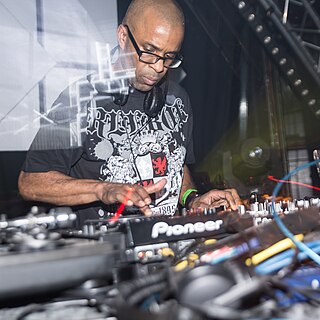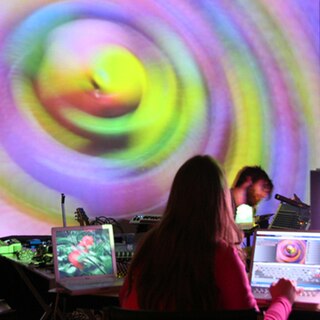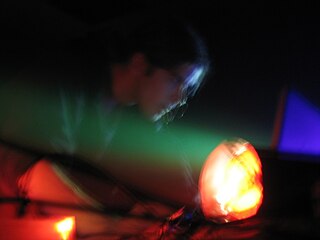Related Research Articles

Drum and bass is a genre of electronic dance music characterised by fast breakbeats with heavy bass and sub-bass lines, samples, and synthesizers. The genre grew out of the UK's jungle scene in the 1990s.

A rave is a dance party at a warehouse, club, or other public or private venue, typically featuring performances by DJs playing electronic dance music. The style is most associated with the early 1990s dance music scene when DJs played at illegal events in musical styles dominated by electronic dance music from a wide range of sub-genres, including drum and bass, dubstep, trap, break, happy hardcore, trance, techno, hardcore, house, and alternative dance. Occasionally live musicians have been known to perform at raves, in addition to other types of performance artists such as go-go dancers and fire dancers. The music is amplified with a large, powerful sound reinforcement system, typically with large subwoofers to produce a deep bass sound. The music is often accompanied by laser light shows, projected coloured images, visual effects and fog machines.
Intelligent dance music (IDM) is a style of electronic music originating in the early 1990s, defined by idiosyncratic experimentation rather than specific genre constraints. The music often described with the term originally emerged in the early 1990s from the culture and sound palette of styles of electronic dance music such as acid house, ambient techno, Detroit techno and breakbeat; it has been regarded as better suited to home listening than dancing. Prominent artists in the style include Aphex Twin, Autechre, Squarepusher, μ-Ziq, the Black Dog and the later duo Plaid, as well as earlier acts such as the Future Sound of London and Orbital.
Breakcore is a style and microgenre of electronic dance music that emerged from jungle, hardcore, and drum and bass in the mid-to-late 1990s. It is characterized by very complex and intricate breakbeats and a wide palette of sampling sources played at high tempos.
Hardcore is a genre of electronic dance music that originated in the Netherlands, Belgium, and Germany in the early 1990s. It is distinguished by faster tempos and a distorted sawtooth kick, the intensity of the kicks and the synthesized bass, the rhythm and the atmosphere of the themes, the usage of saturation and experimentation close to that of industrial dance music. It would spawn subgenres such as gabber.
Speedcore is a form of electronic music that is characterized by a high tempo and aggressive themes. It was created in the early to mid-1990s and the name originates from the hardcore genre as well as the high tempo used. Songs are usually classified as speedcore at around 300+ beats per minute (BPM), but this can vary.
Bouncy techno is a hardcore dance music rave style that developed in the early 1990s from Scotland and Northern England. Described as an accessible gabber-like form, it was popularised by Scottish DJ and music producer Scott Brown under numerous aliases.
Nasenbluten were an Australian electronic music group, formed in Newcastle in 1992. The group was made up of Aaron Lubinski, David Melo, and Mark Newlands, and released six studio albums before disbanding in 2001. They have been described as a significant influence on the breakcore genre.

VJing is a broad designation for realtime visual performance. Characteristics of VJing are the creation or manipulation of imagery in realtime through technological mediation and for an audience, in synchronization to music. VJing often takes place at events such as concerts, nightclubs, music festivals and sometimes in combination with other performative arts. This results in a live multimedia performance that can include music, actors and dancers. The term VJing became popular in its association with MTV's Video Jockey but its origins date back to the New York club scene of the 1970s. In both situations VJing is the manipulation or selection of visuals, the same way DJing is a selection and manipulation of audio.
Drum and bass is an electronic music genre that originated in the UK rave scene having developed from breakbeat hardcore. The genre would go on to become one of the most popular genres of electronic dance music, becoming international and spawning multiple different derivatives and subgenres.

Cyberdelic was the fusion of cyberculture and the psychedelic subculture that formed a new counterculture in the 1980s and 1990s.

Jan Robbe, otherwise known by his music project aliases Atomhead, Erratic, UndaCova and Diagnostic, is an electronic music artist. He founded the experimental netlabel Entity in 2003 with friend Nico de Gols. Jan Robbe is known for expressing various musical styles under different pseudonyms. Atomhead and UndaCova, his two most prominent projects, focus on fractured industrial beats and densely textured DSP sound design techniques, whereas Erratic is a vehicle for pursuing more minimal long-form ambiental directions. The most recent (2018) Diagnostic project explores experimental sound design, glitch and noise structures, combining digital and modular synthesis. Robbe has released music on distinguished labels such as Dyslexic Response and Hangars Liquides, and collaborated with artists who operate in similar aesthetic domains, including La Peste, Neurocore, Subskan and Xanopticon.
Techno is a genre of electronic dance music which is generally produced for use in a continuous DJ set, with tempos being in the range from 120 to 150 beats per minute (BPM). The central rhythm is typically in common time (4/4) and often characterized by a repetitive four on the floor beat. Artists may use electronic instruments such as drum machines, sequencers, and synthesizers, as well as digital audio workstations. Drum machines from the 1980s such as Roland's TR-808 and TR-909 are highly prized, and software emulations of such retro instruments are popular.
Dub techno is a subgenre of electronic music that originated in the early 1990s, blending the repetitive, minimal structures of techno with the echo-laden, spacey production techniques of dub music. It is notable for its deep, atmospheric soundscapes, layers of elaborate basslines, slowly developing musical phrases featuring heavy delay and reverb effects. Vocals are either absent, or inspired by dub and ambient music.
New beat is a Belgian electronic dance music genre that fuses elements of new wave, hi-NRG, EBM and hip hop. It flourished in Western Europe during the late-1980s.
InFiné is a French record label founded by Alexandre Cazac and Yannick Matray. Initially focused on electronic music, the label's representations has branched out into classical music, ambient, club and pop.
Dreampunk is a microgenre of electronic music characterized by its focus on cinematic ambience and field recordings, combined with various traits and techniques from electronic genres such as techno, jungle, electro, and dubstep.
Belgian hardcore techno is an early style of hardcore techno that emerged from new beat as EBM and techno influences became more prevalent in this genre. This particular style has been described as an "apocalyptic, almost Wagnerian, bombastic techno", due to its use of dramatic orchestral stabs and menacing synth tones that set it apart from earlier forms of electronic dance music. It flourished in Belgium and influenced the sound of early hardcore from Netherlands, Germany, Italy, UK and North America during the early-1990s, as a part of the rave movement during that period.
References
- ↑ Socio-anthropological book about the techno scene with a lot of references on hangars liquides - Author Michel Van Grevelinge - l'Harmattan editions 2010
- ↑ Extensive article about Flashcore and Hangars Liquides - "spannered" blog - author Jon Weinel - 2007
- ↑ Manifesto Archived 2018-04-07 at the Wayback Machine of Hangars Liquides. Retrieved 29 September 2013.
- ↑ The Guardian features a video of Hangars Liquides as the world's largest cyberpunk city - 2014